Fatal Friends, Deadly Neighbors Read online
Page 22
Adam Shacknai, Jonah’s younger brother, was a tugboat captain in Memphis, Tennessee. He rushed to his brother’s mansion as soon as their father called to tell him that Max had been critically injured. He was in the guesthouse of the mansion and Becky was in the main house on the night she perished. Adam called 911 and asked for help for her.
The front entrance to the Spreckels Mansion with police crime scene tape.
An aerial view of the Spreckels Mansion in Coronado, California, marking the main house and the smaller structures.
San Diego County sheriff’s investigators and Coronado police detectives walk along a driveway on the murder site’s grounds. Detective sergeant Angela Tsuida, in the center wearing tan slacks, was appointed to head the probe for the sheriff.
The lavish Spreckels Mansion was a Coronado showplace that once hosted the future Duke and Duchess of Windsor, Edward VIII and Wallis Simpson.
Broken chain where the chandelier hanging over the foyer—two floors down—snapped or was cut and Max fell.
Landing where Max fell. Looking down to the foyer. Max may have been going too fast on his scooter. It was found beside him two floors below.
Max and Jonah, father and son, posing together.
Becky Zahau’s driver’s license from Arizona, where she worked as an ophthalmologist’s surgical assistant.
Table with broken leg. Adam said he pushed it over beneath where Becky was hanging and managed to cut her down.
A cryptic message painted on the outside of the door to Becky Zahau’s office/spare room. SHE SAVED HIM CAN YOU SAVE HER. No one ever discovered who wrote it or what it meant.
A reddish-orange towrope for waterskiing tied to the white iron frame of the bed in Becky’s office. Note paintbrush and criminalist’s marker.
The towrope stretched from the white iron bed leg, across the floor, over the railing, knocking down a chair on the way. Did Becky Zahau tie herself up with it and deliberately plunge over the high wrought iron railing? Was she even up there in her last moments of life?
DOUBLE DEATH
FOR THE KIND
PHILANTHROPISTS
If ever a man deserved to spend his retirement years in peace and comfort, it was eighty-five-year-old Burle D. Bramhall. Certainly the old man was wealthy, and his fifty-five-year marriage to his one sweetheart, Olive, eighty-three, was as idyllic as it had been when they first took their wedding vows. Their sumptuous home in one of Seattle’s richest and oldest neighborhoods—Windermere—was just right for them. The Bramhalls lived the kind of retirement that anyone might aspire to.
Nobody who knew Burle Bramhall resented his good fortune, however, for his whole life had been one of service to others and philanthropy.
Almost ninety years ago, Bramhall was a vigorous man in his twenties. During World War I, he worked with the American Red Cross, and he managed to shepherd 783 youngsters out of Siberia for reunions with their families. Like a pied piper, he led the little ones from country to country until they were once again safe in their parents’ arms.
In 1973, when they were over eighty, Burle and Olive were guests of the Soviet Union. There they were reunited with more than two hundred of those children Burle had saved. The “children” had long since grown to late middle age themselves. In the years after that joyous meeting, the Bramhalls’ mailbox was always full of letters from these old friends who never forgot what he had done for them. He always found time to write back to those he had rescued, and his small study was crowded with mementoes they sent him.
He and Olive had never been blessed with children of their own, but they felt the children from Siberia who called him “Godfather” were somehow theirs, too.
* * *
For all of his long life, Burle Bramhall had been a consummate businessman. His accounting studies at the University of Oregon were interrupted by his Red Cross services in World War I, but, on his return to Seattle, he finished his education and went to work handling investments for the Marine National Bank. There he met the man who would be his partner for more than thirty years in the investment firm of Bramhall & Stein.
During World War II, Bramhall took a leave of absence and went to Paris and London to work with health and welfare agencies geared to serve the survivors of the second great war, and once more he immersed himself in helping displaced persons. He was approaching fifty then, but it didn’t matter.
Although his partner retired in 1969, Burle Bramhall never really did. Right up until the end of his life, he was associated with Blyth & Company, rated then as the nation’s largest investment house not tied to the New York Stock Exchange.
Burle always tempered a good business head with concern for those who had nothing. He felt grateful that he had been given—and earned—much, and he believed he owed something back.
And Olive felt the same way. The elderly couple were still having a lot of fun in their eighties. Their neighbors in Windermere often chuckled to see them all dressed up and stepping out for the evening. Their age slowed them down a little, but even so, they were considered the “night owls” of the neighborhood, driving out grandly with Burle behind the wheel of his polished 1963 Mercedes. The tall old man was a little stoop-shouldered now, but he still treated the petite Olive with all the courtliness he had used when they were first married.
When the Bramhalls’ lights were on late on the warm summer night of Wednesday, August 2, 1978, no one thought anything of it; neighbors figured Burle and Olive were watching television a little later than they usually did.
It was sometime after midnight on August 3 when the 911 emergency line at Seattle police headquarters rang and Operator 63 picked up the receiver. The conversation was terse, but also frightening.
“911 Operator 63.”
“Yes . . . I would like to get connected to the police . . .”
“This is the police department.”
“Okay . . . there was a murder at 6647.”
“When was this?”
“I don’t know.”
“There was a murder?”
“Yeah . . . two of them.”
“ . . . 6647 Windermere Way . . .”
“Yes.”
Before the operator could ask any further questions, the line went dead. The caller was a man who had no discernible accent, and that was all the operator could say about him. He jotted down the information and passed it to the radio dispatcher.
The first officers dispatched from the Wallingford Precinct in Seattle’s north station were Gordon Van Rooy, F. R. Solis, and Dale Eggers, sent to check on a “possible homicide.”
They turned into a divided private lane that led to several large homes and pulled up in front of the two-story L-shaped house marked BRAMHALL.
Solis covered the back while Van Rooy and Eggers approached from the front. The front door was standing open while the screen door was closed; the two officers could see the very dim light of a fluorescent grow light over a planter just inside. They could also see that a sliding glass door to what seemed to be a den was standing open, and the TV inside was still on, with only the test pattern on the screen.
Van Rooy and Eggers found no one in the den or in the adjoining bedroom. Beyond that was a hall with three doors—all closed—along it, and another hall just beyond that.
“Nothing out back,” Solis commented as he joined them.
The three officers checked the closed doors. One was locked, and the other two led to a second bathroom and another bedroom, both empty. Neither showed signs of a struggle or ransacking.
They kicked open the locked door. There was nothing inside but a laundry room. It was eerie moving through the silent house, not knowing if a murder had, indeed, taken place and, if it had, a killer still waited behind one of the myriad doors.
Solis and Eggers crept down the second hall—which led to the foyer—when suddenly Solis stopped short. “There’s a body,” he whispered.
And there was. The two patrol officers gazed down at the form of a small an
d frail woman with white hair. She was prone on the floor between the kitchen and foyer. A large pool of still-wet blood glistened on the kitchen floor tiles.
The patrolmen moved toward a door leading into the garage. That door, too, was locked, but gave with a sharp kick.
There was an old man lying there, crumpled in death beside a parked Mercedes. A copious amount of blood streamed from his head and ran along the floor for approximately eight feet.
In the seventies, there were no shoulder phones, so Van Rooy ran to his patrol car to call radio dispatch and confirm that the report of two homicides was true. Lieutenant Ivan Beeson, himself a longtime homicide detective sergeant before a recent promotion to the north precinct, left at once to join his men. In the meantime, the dispatcher alerted homicide detective sergeant Craig VandePutte, and detectives Gary Fowler and Dick Reed at home.
It was 2:30 A.M., and none of the detectives would sleep anymore that night.
The homicide investigators parked their vehicles in a paved area just outside the Bramhalls’ garage. They were briefed by the officers already at the scene. So far, no one knew who might have attacked the elderly couple. There had been one anonymous call to 911 from a man who would not give his name.
“The den, garage, and kitchen lights were on when we got here,” Van Rooy said. “And the sliding door to the den as well as the front door were open. We haven’t touched a thing, except for the light switch in the living room.”
Sergeant VandePutte took one look at the large house and two separate body sites, and quickly realized they would need more backup. Detective Lieutenant Ernie Bisset and detectives John Boatman and Bill Baughman were also called at home and asked to join the crew in Windermere. They arrived just after 4 A.M.
Gary Fowler photographed the entire home prior to any attempt to remove evidence. The Mercedes was still parked in the garage, but there was space there for a second car, so Dick Reed asked for a check on all vehicles registered to either Burle or Olive Bramhall; it was possible that the killer had left in one of their cars. Word came back from the Department of Motor Vehicles that Olive Bramhall owned a blue 1976 Oldsmobile Omega. A bulletin was put out at once asking all officers on duty in the city and the county to locate that car.
Detectives studied the pitiful bodies. Burle Bramhall was fully clothed in light slacks and a blue sweater, shoes, and socks. His expensive watch was still on his wrist, but his glasses and hearing aid had been knocked off and lay near the Mercedes. A leather case with keys was almost underneath the car.
The old man’s head rested on a board used as a stop for parked vehicles, and it appeared that he had suffered tremendous blows that had literally shattered his skull and knocked his dentures out of his mouth. A half-smoked cigar butt was close by. Was it the victim’s? If so, he had apparently been struck unaware—perhaps by someone he trusted. It was bagged and marked as evidence, along with the glasses and keys on the garage floor.
The garage was neatly arranged, with bins for nails, gardening supplies, and tools hung in place, their outlines drawn on a perforated board that lined one wall.
The tiny body of the old woman was dressed in a multicolored dress, nylons, and white high-heeled shoes. She had fallen from the blows to her head so quickly that her hands were caught underneath her body. She, too, had sustained horrendous head injuries. Her wig and glasses had been knocked off by the force of the blows. The back spatter of her blood was medium velocity—indicating that her killer had probably used a blunt instrument of some kind. It had sprayed and splattered the immaculate kitchen as she fell, and then puddled beneath her.
The elderly victims must have been up and awake when their killer arrived. They were completely dressed, and the television was still on. There were no signs at all of forced entry.
Dr. Donald Reay, the King County medical examiner, arrived at 5 A.M. He verified that the cause of death was from head wounds—probably from a blunt object. He checked their body temperatures, and estimated lividity and rigor mortis.
“I think they’ve been dead about eight hours,” he commented. “That would mean that they were killed about nine last night.”
As the bodies were removed, Reay said that Burle Bramhall had sustained four blows to the head, almost any one of which would have been fatal to a man of his age. Olive had a wound to the side of her head and one in the back. “It looks like she was hit in the back of the head, fell, and the second wound was administered as she lay on the floor.”
It was beginning to get light, and the patrol officers searched the area around the home. Dale Eggers located a large sledgehammer, weighing approximately five pounds, in a vacant lot next door to the victims’ home.
It was obviously the murder weapon. There were bloodstains, hair, and what appeared to be brain matter evident on the hammer.
Full daylight dawned as the last of the physical evidence was bagged and labeled. Dick Reed removed the trap from the kitchen sink in the event the killer might have washed his hands there. No one knew about DNA thirty years ago, but if he found blood traces there, they could at least check for blood type, and, if it was different from that of the two victims, they might be able to find the third person—or persons—who had been in the house.
This was a terribly ugly way for two kind old people to die, and inexplicable; although the Bramhalls were wealthy, robbery didn’t seem to be the motive. The routine things that thieves take were still in place in the house: televisions, radios, silver, and crystal. Although Olive’s car was gone, there were far easier ways to steal a car than to resort to such carnage.
Moreover, both of the Bramhalls still wore expensive jewelry, worth thousands of dollars. It was possible that there were items of great value that had been taken, but they were certainly not obvious.
And no one had broken in. Why would Burle Bramhall willingly admit the killer? They were not paranoid, but they were cautious and it wasn’t likely they would let a stranger in after dark.
There were some oddities—a piece of ivy resting on a table in the hall, a blank spot where the poker from the fireplace set was missing. And then it too was found in the vacant lot next door.
At 7:10 in the morning, John Boatman and Bill Baughman talked to the neighbors beyond the vacant lot just to the north of the Bramhall house. The Addison* family members were longtime neighbors of the victims. Cal Addison* and his younger son said they had heard nothing during the night. They had seen that the lights were on in the garage, but that wasn’t particularly unusual. As for Mrs. Bramhall’s missing car, Addison said that the couple’s housekeeper usually drove the car and had permission to take it home when she left for the night after serving dinner.
Now the investigators set out to locate the housekeeper.
The home on the other side of the Bramhalls’ house was a mansion that had recently been purchased by the followers of the controversial Reverend Sun Myung Moon, leader of the Unification Church, or “Moonies,” a religious cult. Not surprisingly, Windermere residents weren’t happy at all to have the “Moonies” in their midst and there had been suits filed against them. None of the neighbors, however, felt that the Bramhalls had had particular difficulties with the oddly dressed Moon followers who came and went from the huge white edifice.
The phone rang in the Bramhall home while the detectives worked and detective Dick Reed answered it. The caller identified himself as the Bramhalls’ insurance agent, and he was aghast as Reed told him that both the elderly people were dead.
“I talked to Burle just last week about an insurance policy, and he told me they’d hired a new housekeeper and that she was the best they’d ever had. I called Burle yesterday afternoon and the housekeeper answered, but she said he was outside doing some gardening and that she didn’t want to call him in, so I just said I’d call today.”
The agent had never seen the housekeeper, and didn’t know her name.
Sergeant VandePutte had found a list of emergency numbers in the home, as well as the guest list
for a party the victims were planning. One number appeared to be that of the housekeeper, Esme Svenson,* and he checked the reverse phone directory for an address for the woman. An investigator was sent to find her.
Detective Al Gerdes talked to a Windermere resident who reported a peculiar incident he’d observed; sometime around 11:30 A.M. on August 2, he’d looked into the Bramhalls’ home and seen a woman he didn’t recognize standing between the living room and the kitchen. He thought she was twenty to twenty-four, with long blond hair falling to the middle of her back.
The day shift of homicide detectives arrived at the crime scene. At nine on the morning after the Bramhalls were killed, a roughly dressed man walked up to the Bramhall house, clutching a piece of paper with the home’s address printed on it. Bewildered by all the activity, he stammered as he explained that he’d come to do some lawn work.
“They sent me out from the Millionair’s Club [a Seattle charity with a deliberately misspelled name that finds jobs for people down on their luck]. I’m supposed to do some cleanup work in the yard.”
The man said he’d never been there before, and detectives believed him. He’d simply drawn the wrong time to show up. They took his name and address, checked with the Millionair’s Club to verify his story, and sent him on his way.
The detectives checked the basement of the Bramhall residence, but it was obvious no one had been there. Cobwebs still hung, undisturbed, but the blood draining from Olive Bramhall’s body had leaked through the tiles and then floorboards above and dripped in a macabre pattern over the freezer and on the floor.

 Too Late to Say Goodbye: A True Story of Murder and Betrayal
Too Late to Say Goodbye: A True Story of Murder and Betrayal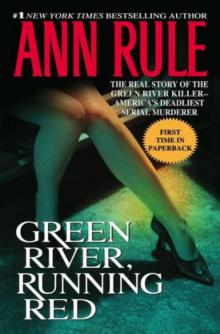 Green River, Running Red
Green River, Running Red Bitter Harvest
Bitter Harvest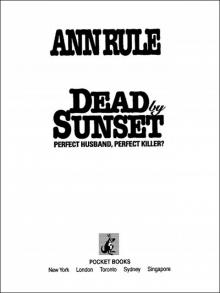 Dead by Sunset: Perfect Husband, Perfect Killer?
Dead by Sunset: Perfect Husband, Perfect Killer?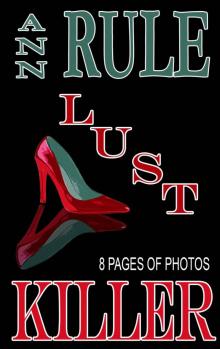 Lust Killer
Lust Killer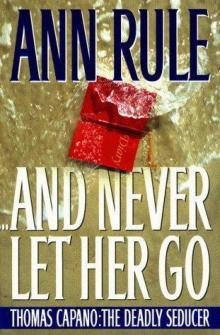 And Never Let Her Go: Thomas Capano: The Deadly Seducer
And Never Let Her Go: Thomas Capano: The Deadly Seducer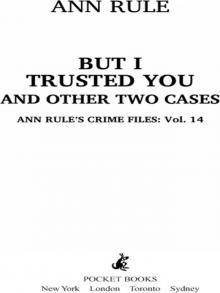 But I Trusted You and Other True Cases
But I Trusted You and Other True Cases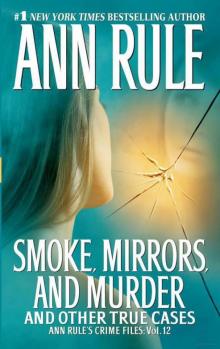 Smoke, Mirrors, and Murder and Other True Cases
Smoke, Mirrors, and Murder and Other True Cases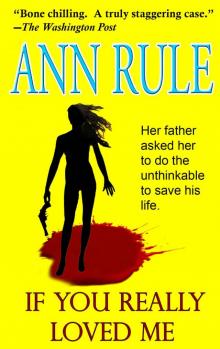 If You Really Loved Me
If You Really Loved Me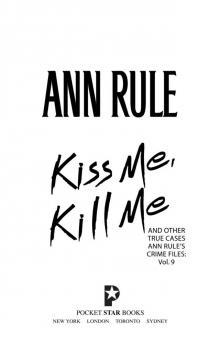 Kiss Me, Kill Me and Other True Cases
Kiss Me, Kill Me and Other True Cases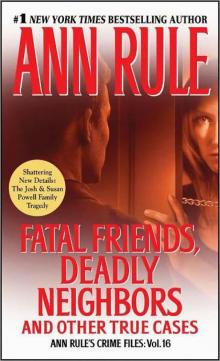 Fatal Friends, Deadly Neighbors and Other True Cases
Fatal Friends, Deadly Neighbors and Other True Cases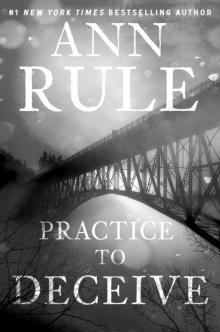 Practice to Deceive
Practice to Deceive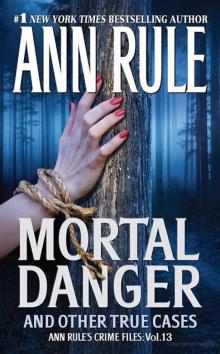 Mortal Danger and Other True Cases
Mortal Danger and Other True Cases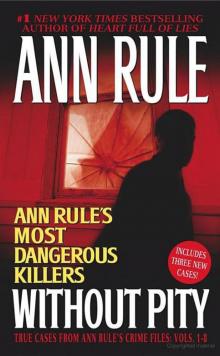 Without Pity: Ann Rule's Most Dangerous Killers
Without Pity: Ann Rule's Most Dangerous Killers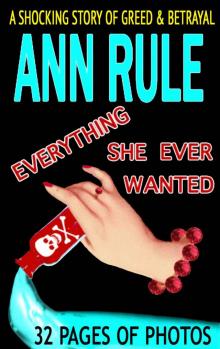 Everything She Ever Wanted
Everything She Ever Wanted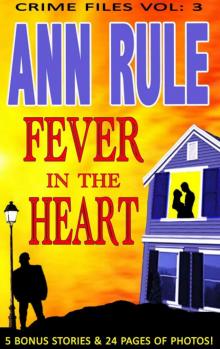 A Fever in the Heart and Other True Cases
A Fever in the Heart and Other True Cases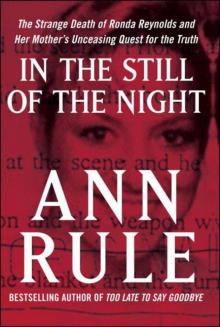 In the Still of the Night
In the Still of the Night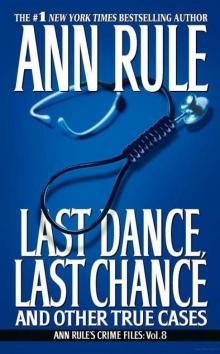 LAST DANCE, LAST CHANCE - and Other True Cases
LAST DANCE, LAST CHANCE - and Other True Cases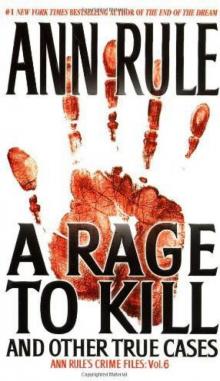 A Rage to Kill
A Rage to Kill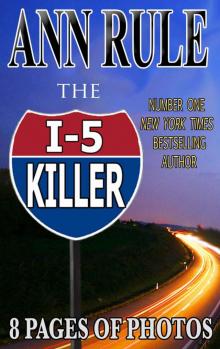 The I-5 Killer
The I-5 Killer The Stranger Beside Me
The Stranger Beside Me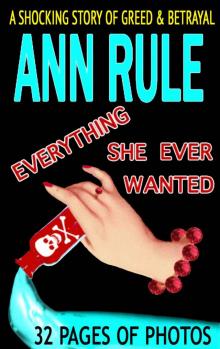 Everything She Ever Wanted: A True Story of Obsessive Love, Murder, and Betrayal
Everything She Ever Wanted: A True Story of Obsessive Love, Murder, and Betrayal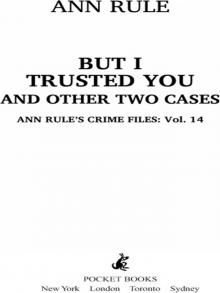 But I Trusted You
But I Trusted You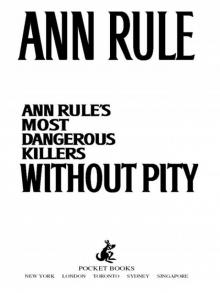 Without Pity
Without Pity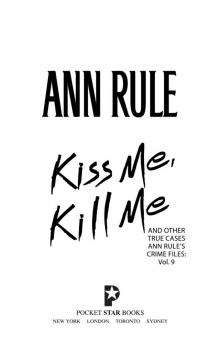 Kiss Me, Kill Me
Kiss Me, Kill Me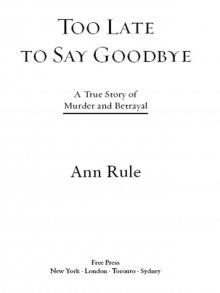 Too Late to Say Goodbye
Too Late to Say Goodbye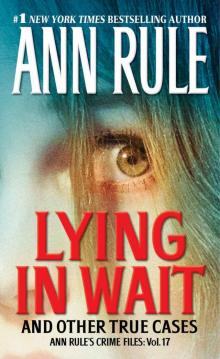 Lying in Wait
Lying in Wait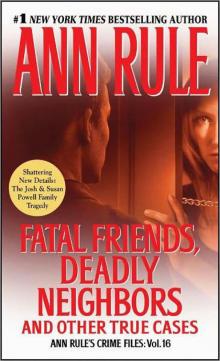 Fatal Friends, Deadly Neighbors
Fatal Friends, Deadly Neighbors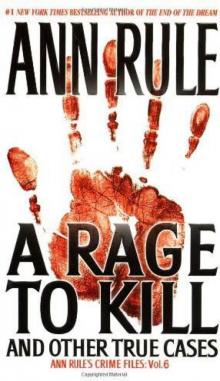 A Rage to Kill: And Other True Cases
A Rage to Kill: And Other True Cases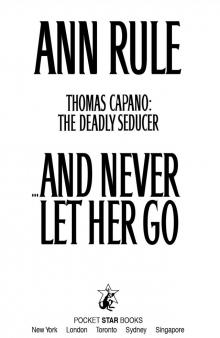 And Never Let Her Go
And Never Let Her Go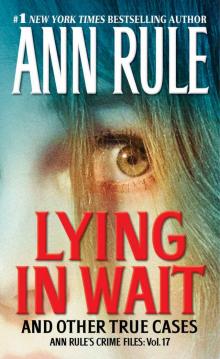 Lying in Wait Ann Rule's Crime Files Vol.17
Lying in Wait Ann Rule's Crime Files Vol.17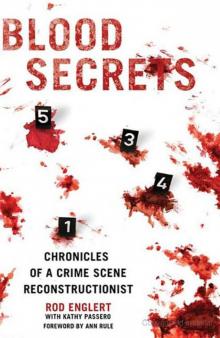 Blood Secrets: Chronicles of a Crime Scene Reconstructionist
Blood Secrets: Chronicles of a Crime Scene Reconstructionist No Regrets
No Regrets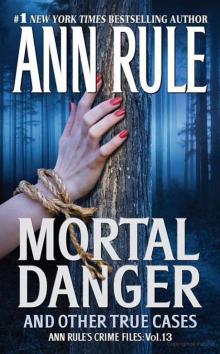 Mortal Danger
Mortal Danger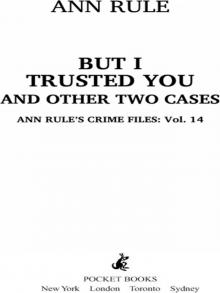 But I Trusted You: Ann Rule's Crime Files #14
But I Trusted You: Ann Rule's Crime Files #14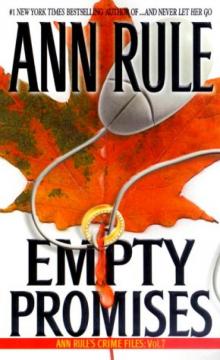 Empty Promises
Empty Promises Dead by Sunset
Dead by Sunset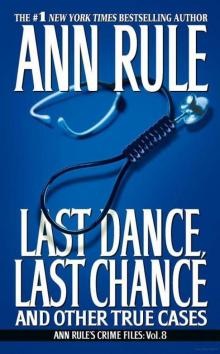 Last Dance, Last Chance
Last Dance, Last Chance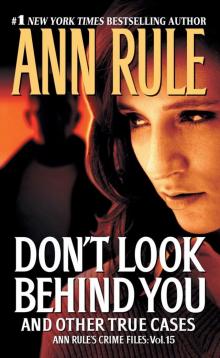 Don't Look Behind You
Don't Look Behind You